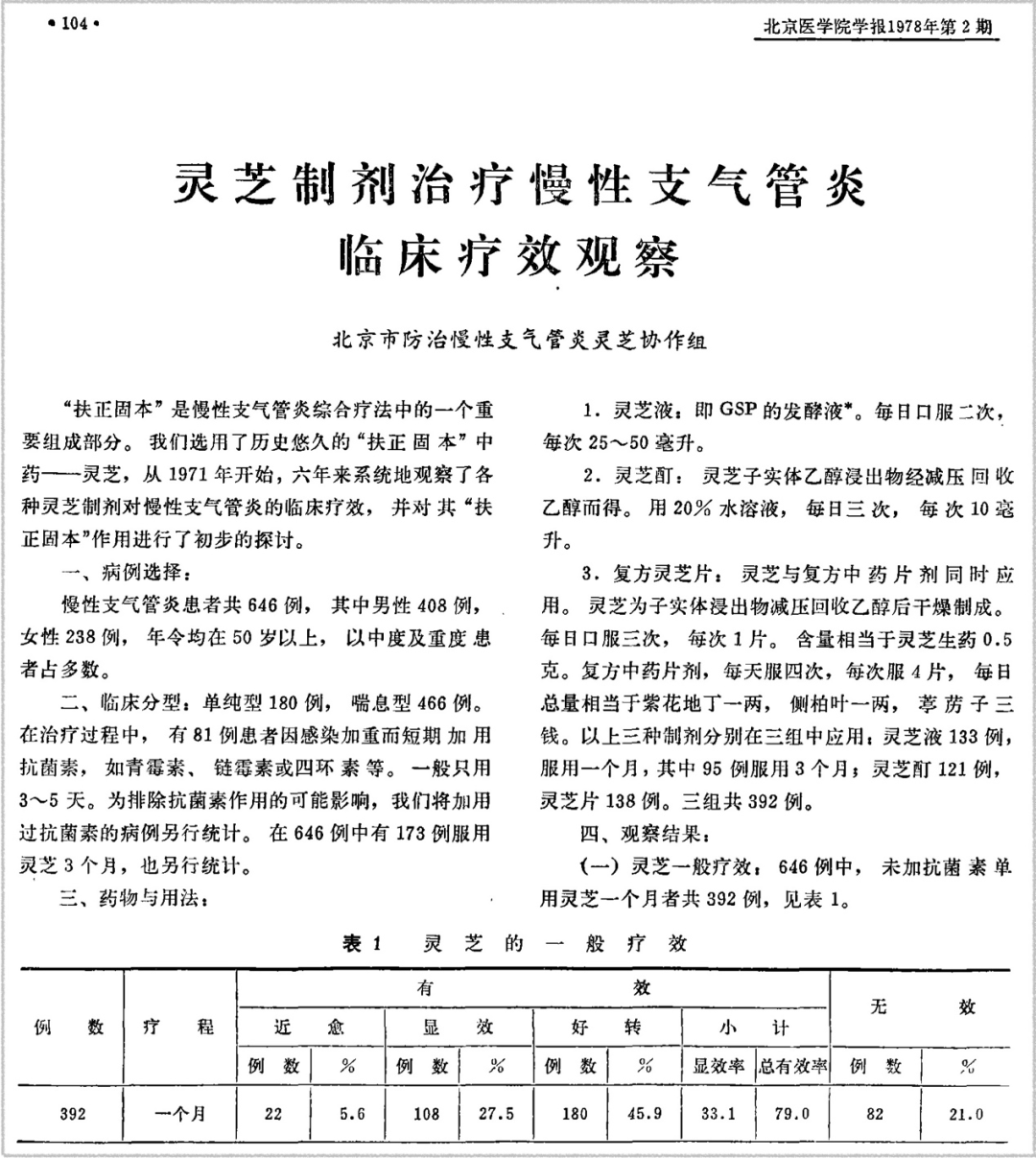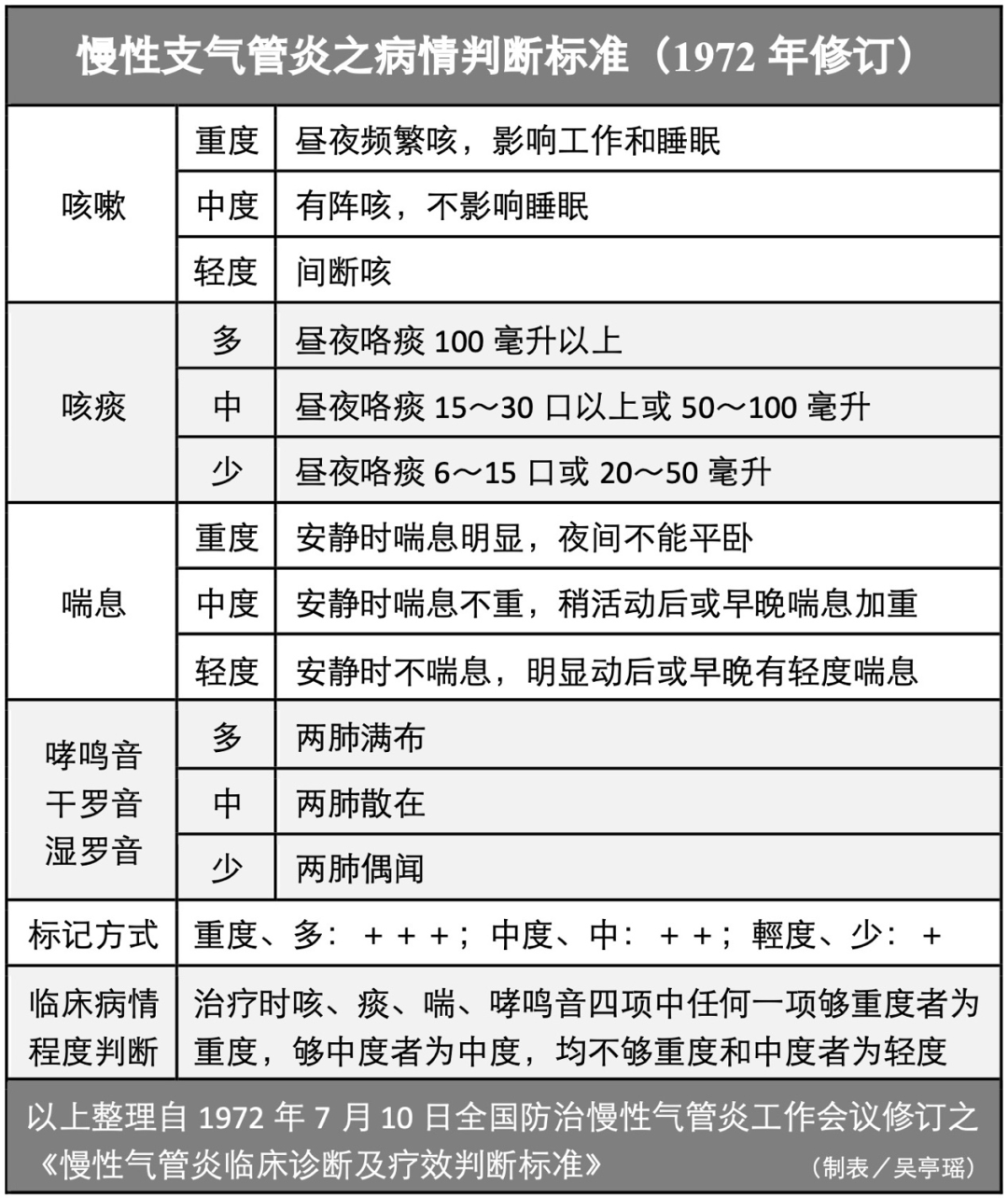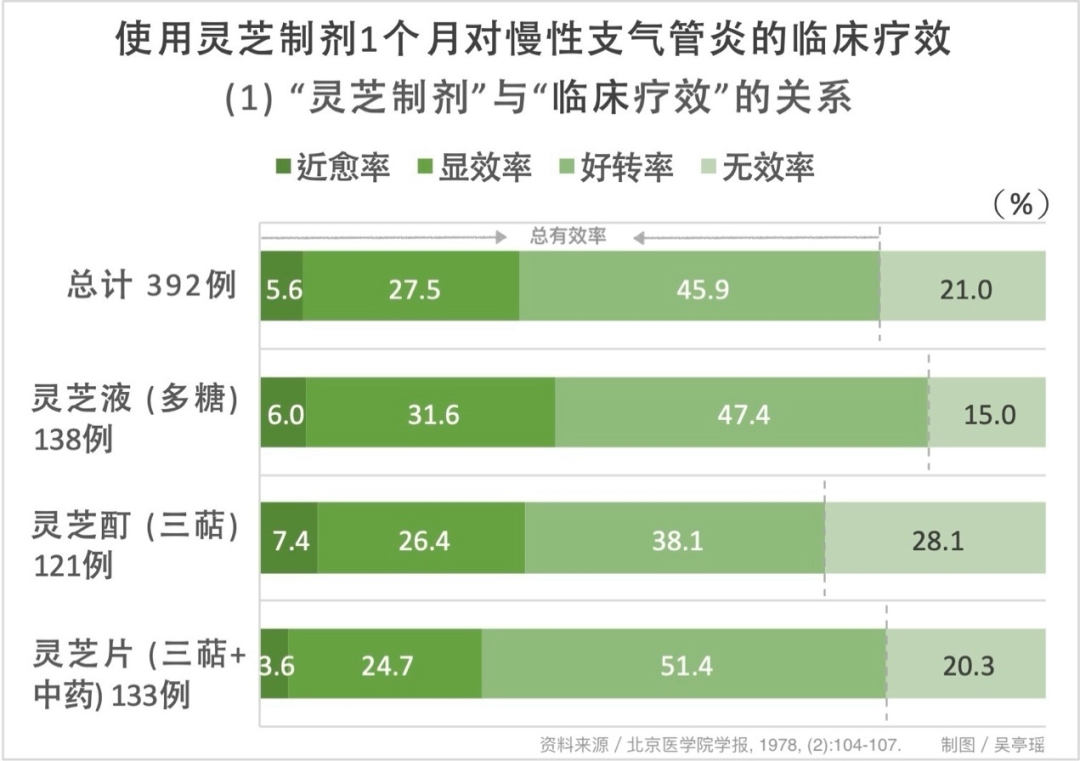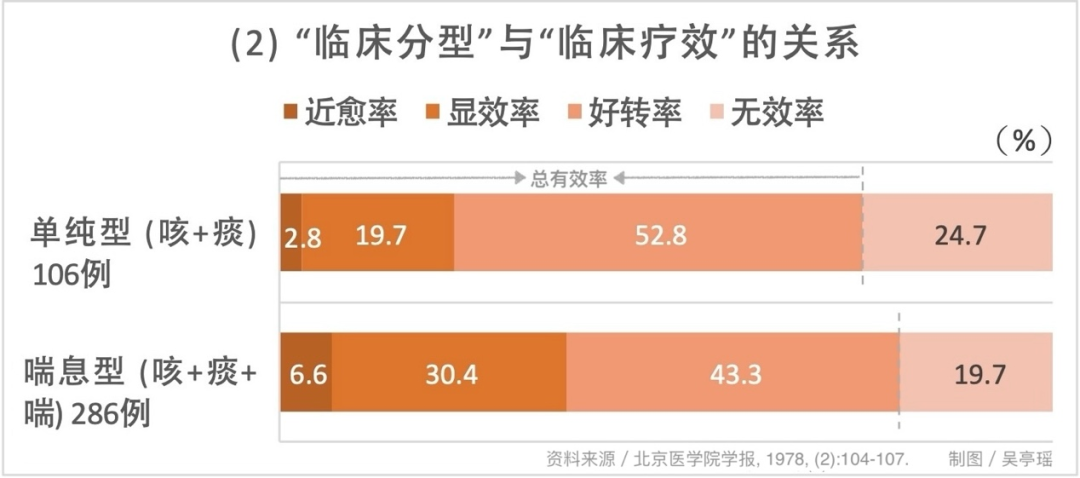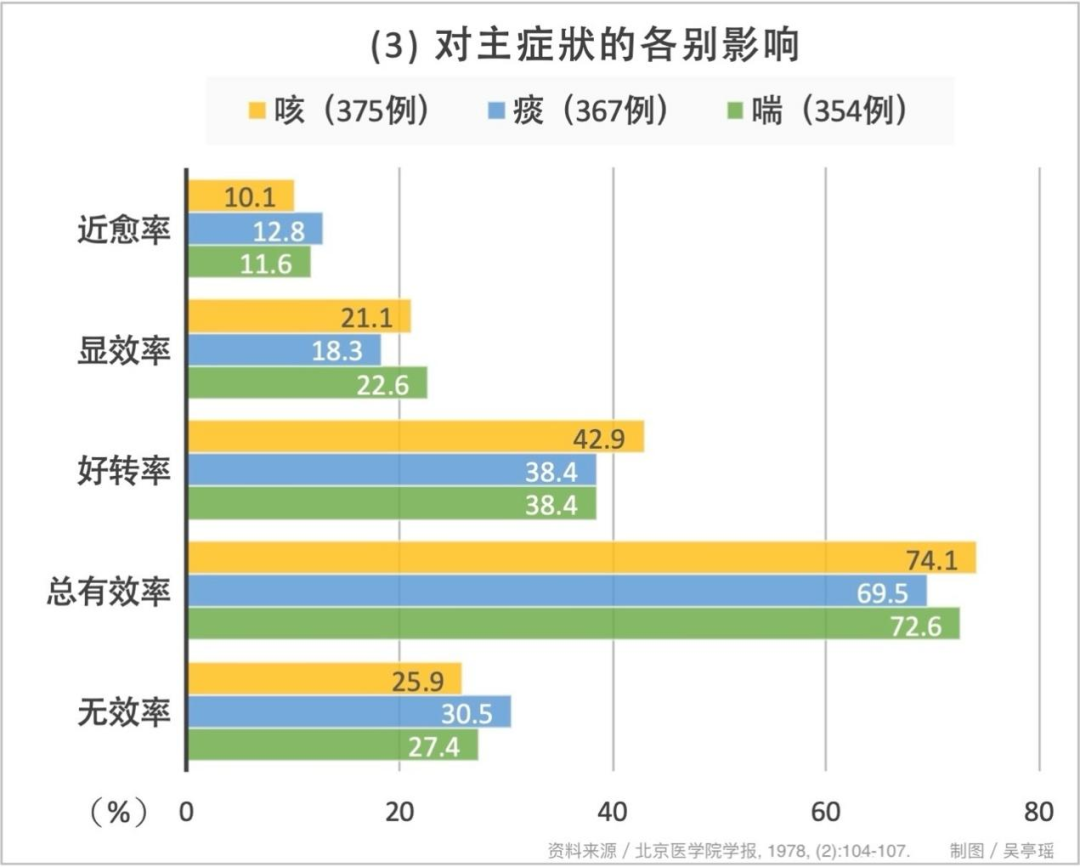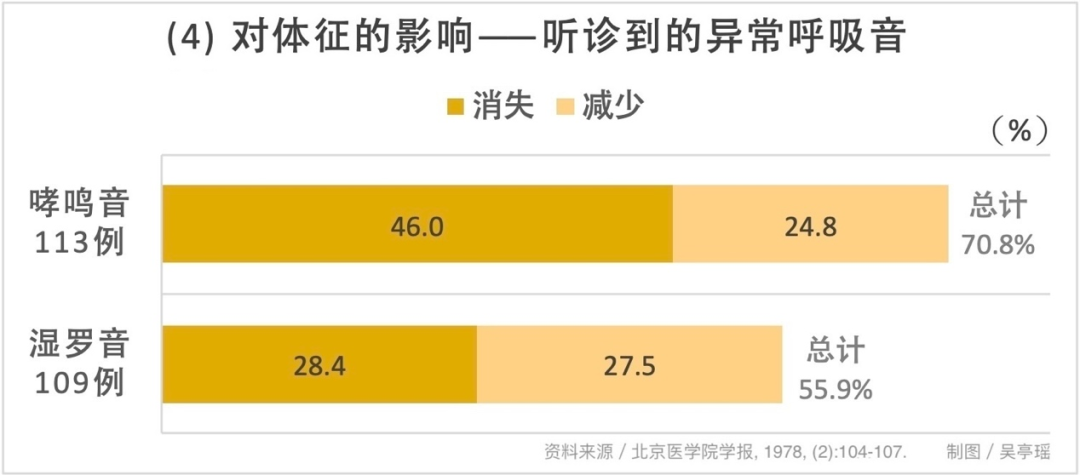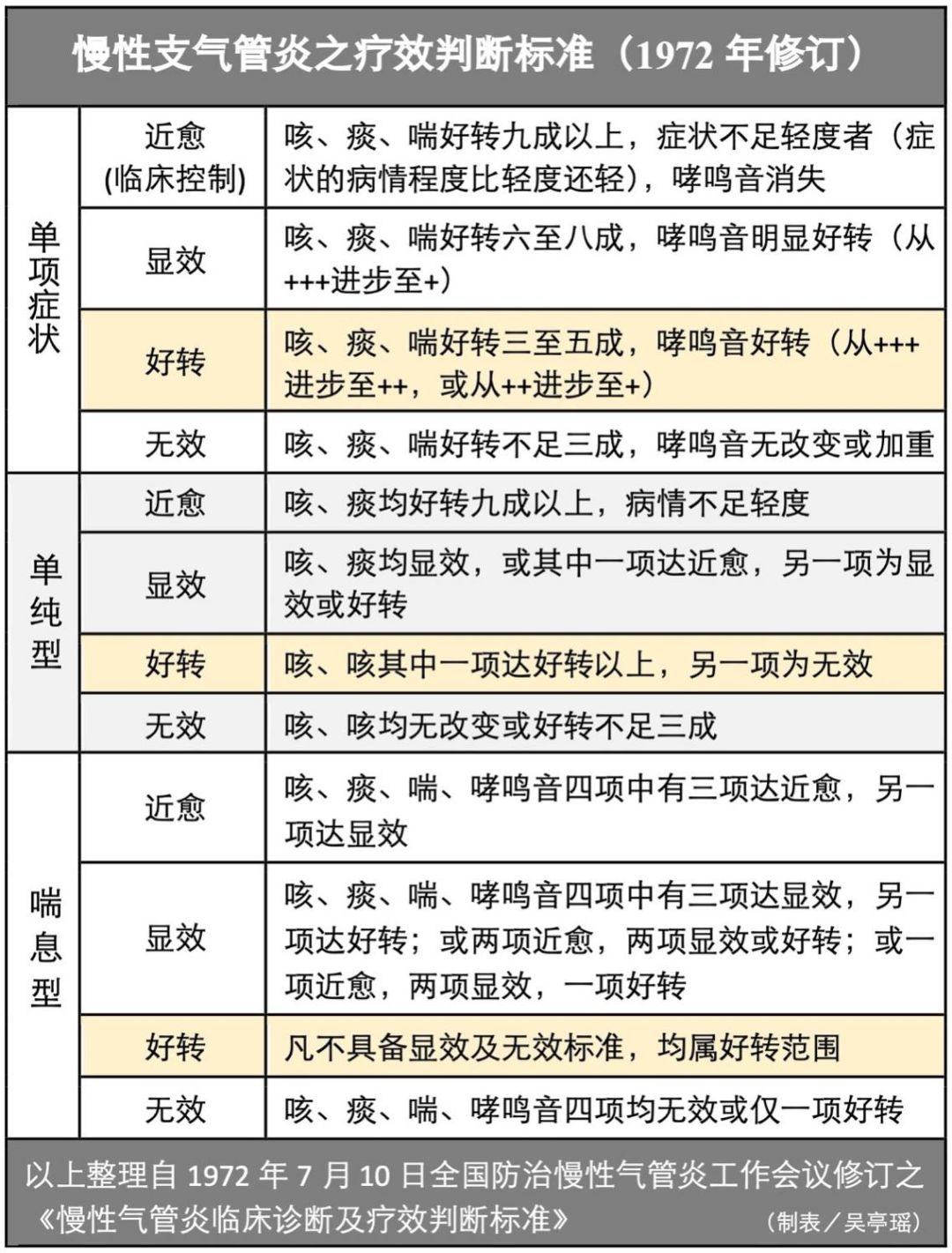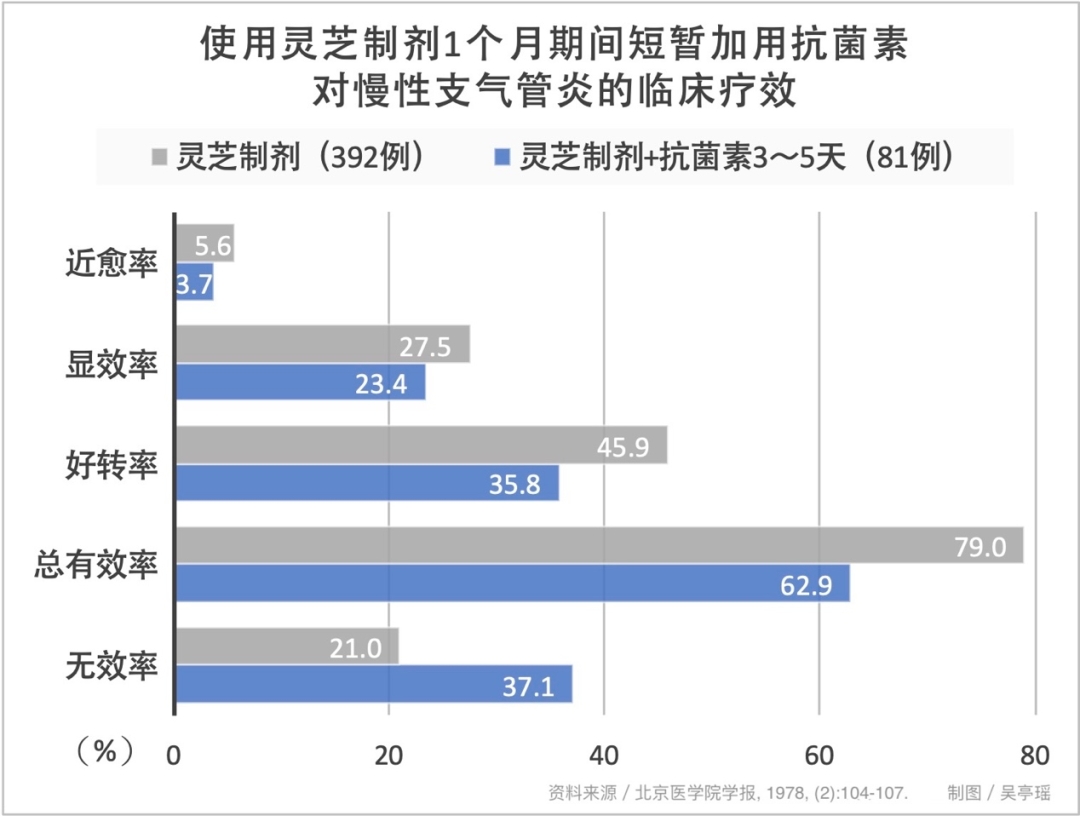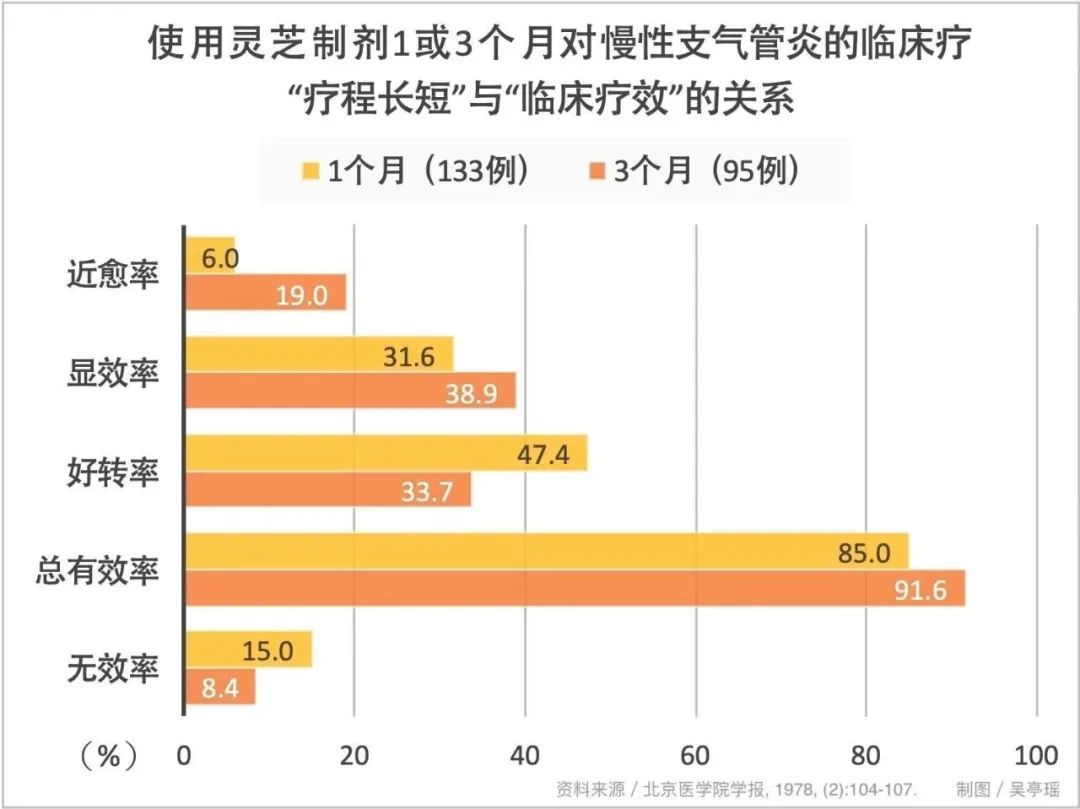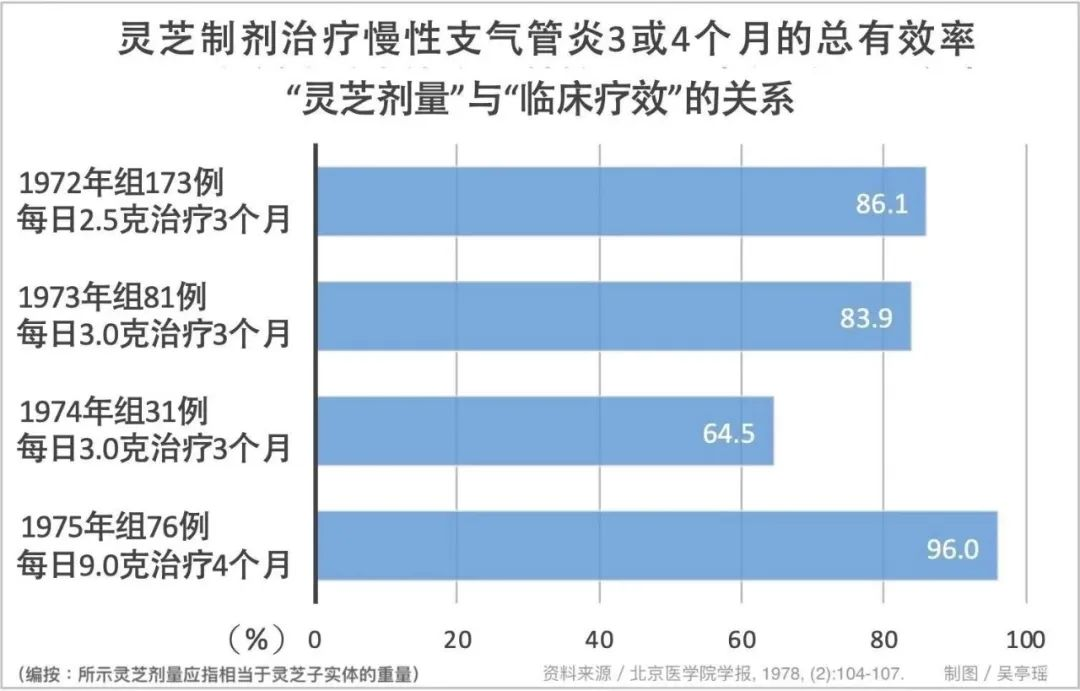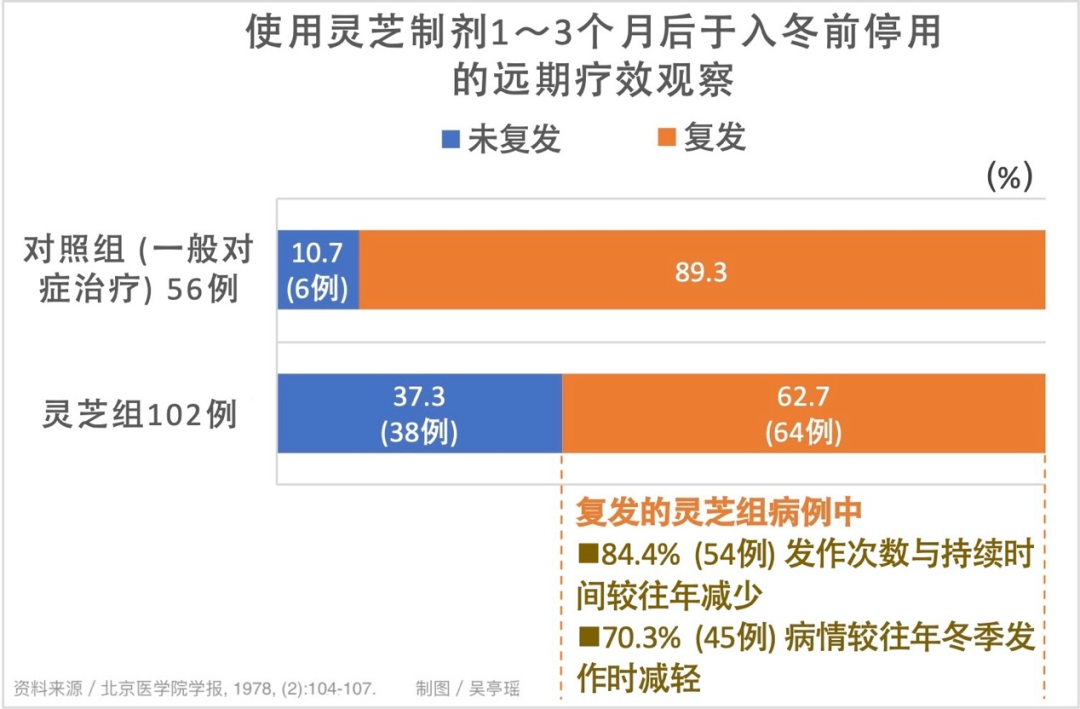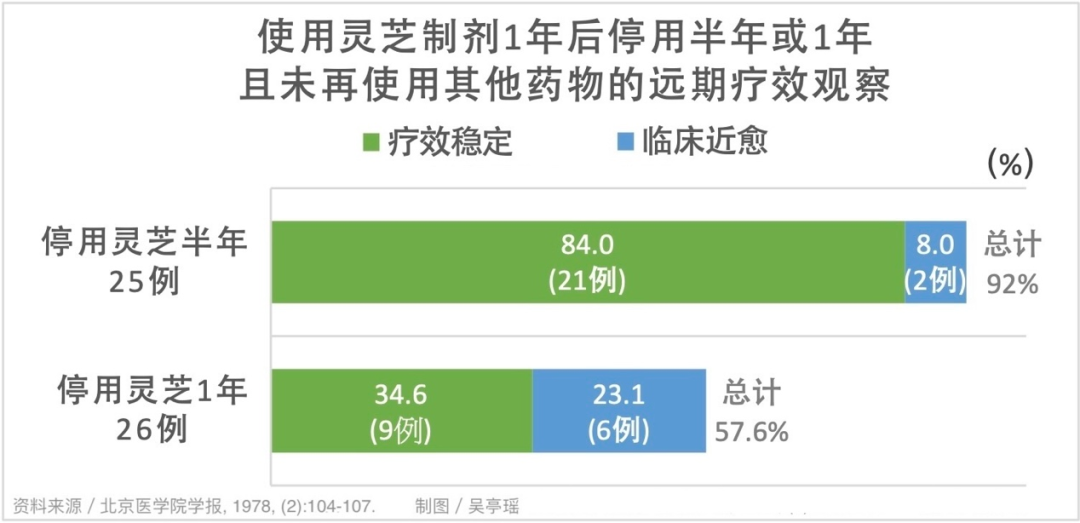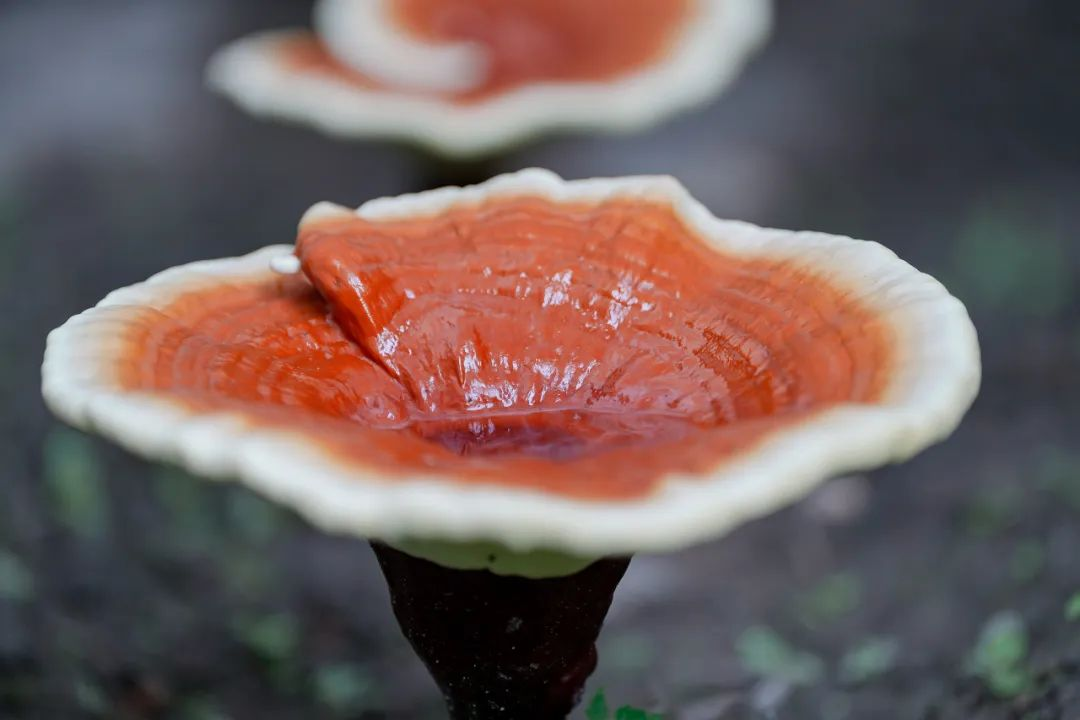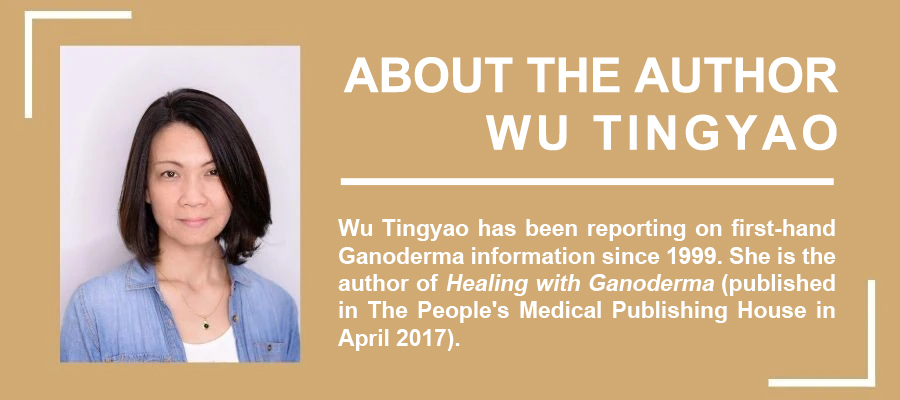Improving and preventing chronic bronchitis is one of the significant effects of Reishi. However, it’s not as simple as “consume Reishi and then stop coughing, stop producing phlegm, and stop wheezing”. It requires certain prerequisites (such as how much to consume and for how long), some understanding (such as the probability of effectiveness), and some basic knowledge (for instance, the mechanism of Reishi differs from that of Western medicine).
To do a good job, one must first sharpen one’s tools. In 1978, the Beijing Ganoderma Collaboration Group for the Prevention and Treatment of Chronic Bronchitis published “Clinical Efficacy Observation of Ganoderma Lucidum Preparations in the Treatment of Chronic Bronchitis” in the Journal of Beijing Medical University. The paper statistically analyzed the application results of three different Ganoderma preparations for more than 600 patients with chronic bronchitis. Its early publication time provided a wealth of knowledge base for how Ganoderma lucidum protects the bronchi in the human body. Its large-scale experiment and systematic exploration are unprecedented, making it an indispensable learning material for pragmatic learners of Ganoderma lucidum.
Home Page (Partial) of the Report on the Clinical Efficacy Observation of Ganoderma Lucidum Preparations in the Treatment of Chronic Bronchitis
The collaborating institutions involved in this study include: The First Affiliated Hospital of Beijing Medical College, The Third Affiliated Hospital of Beijing Medical College, People’s Hospital Affiliated to Beijing Medical College, Jishuitan Hospital of Beijing, Friendship Hospital of Beijing, Children’s Hospital of Beijing, Xuanwu Hospital of Beijing, Construction Workers’ Hospital of Beijing, Infectious Disease Hospital of Beijing, and Anding Hospital of Beijing.
Disease Definition, Clinical Typing, Severity of Condition
The diagnostic criteria for chronic bronchitis in the early 1970s were basically similar to those of today: the main symptoms are cough and expectoration, or accompanied by shortness of breath; symptoms will recur, with the disease occurring at least three months a year and lasting for more than two years; other cardiopulmonary diseases (such as tuberculosis, pneumoconiosis, lung abscess, bronchial asthma, bronchiectasis, heart disease, etc.) causing cough, sputum, and shortness of breath are excluded.
There are two clinical types: 1. Simple type: characterized by two symptoms, cough and expectoration. 2. Dyspnea type: characterized by three symptoms, cough, expectoration, and shortness of breath, and often presents with wheezing sounds. The judgment of mild, moderate, and severe conditions is basically based on whether it will affect work, sleep (cough, dyspnea), or the amount (sputum, wheezing). Any symptom that reaches the moderate or severe level is considered a moderate or severe patient.
In this study, patients with both clinical types of chronic bronchitis are included, with the majority being of moderate to severe conditions, and all are aged 50 and above.
❖ What is “wheezing sound”? Please refer to: https://baike.baidu.com/item/wheezing sound/2481335
❖ What are “dry rales” and “wet rales”? Please refer to: https://e.dxy.cn/wisdom/front/zhihuihao/5316
The main features of the three Ganoderma lucidum preparations: polysaccharides, triterpenes, and used in conjunction with traditional Chinese medicine.
In this study, three types of Ganoderma lucidum preparations were provided for the subjects to use. The contents and daily dosage are detailed in the original report excerpted at the beginning of the text. According to the report’s description of these Ganoderma lucidum preparations, and the relevant records in the monograph “Ganoderma” (Reference 3) published in the same period, we know:
The raw material of “Ganoderma Liquid” is the mycelium and its fermentation metabolites. The main active ingredient is “Ganoderma Polysaccharides”, and there are also amino acids and trace proteins. 50 to 100 milliliters are taken twice daily.
The raw material of “Ganoderma Tincture” is the ethanol extract of Ganoderma lucidum fruiting body. The main active ingredient is “Ganoderma Triterpenes”. Before use, 100% Ganoderma Tincture is diluted with water to 20% for consumption, 30 milliliters three times a day. According to the common practice of Ganoderma Tincture at that time, every milliliter of 100% Ganoderma Tincture is equivalent to 1 gram of Ganoderma lucidum fruiting body. Therefore, the subjects in this study who took Ganoderma Tincture are equivalent to consuming the concentrated essence of 6 grams of Ganoderma lucidum fruiting body every day.
The raw material of “Ganoderma Tablet” is also the ethanol extract of Ganoderma lucidum fruiting body, but starch is added as an excipient. The main active ingredient is still Ganoderma Triterpenes. It is taken orally three times a day, 3 tablets each time, which is equivalent to consuming the concentrated essence of 1.5 grams of Ganoderma lucidum fruiting body every day. Because the patients who took Ganoderma Tablets in this study also took compound Chinese medicine tablets at the same time (equivalent to eating 1 tael of Viola phillipina + 1 tael of Platycladi cacumen + 3 mace of Descurainiea Semen every day), we can regard the efficacy of the “Ganoderma Tablet” group as the effect of “Ganoderma Triterpenes used in conjunction with traditional Chinese medicine”.
The overall effectiveness of using Ganoderma lucidum for one month is at least 70%.
From the report showing that the overall efficiency (near cure rate + marked effect rate + improvement rate) in all aspects of 392 patients with chronic bronchitis using Ganoderma lucidum preparations for one month is at least 70% (as detailed in the figure below), it can be seen that although the efficacy characteristics and mechanisms of action of Ganoderma polysaccharides and Ganoderma triterpenes are quite different, these two components seem to be able to simultaneously reduce the symptoms of the cough, sputum, and wheezing of patients with chronic bronchitis, as well as the wheezing sounds and wet rales in the lungs; even when used in conjunction with traditional compound Chinese medicine used to clear the lungs, dissipate stasis, and relieve cough and reduce sputum, it can also play a synergistic and non-contradictory bonus effect.
Despite the fact that over a quarter (27.7%) of the cases in the dyspnea group were severe, compared to just under a sixth (15.6%) in the simple group, after one month of using Ganoderma preparations, it was the dyspnea cases that had a higher rate of near recovery, marked effectiveness, and overall effectiveness. Therefore, researchers believe that Ganoderma preparations seem to have a more significant effect on dyspnea patients with relatively complex symptoms.
Further referring to the efficacy judgment criteria for chronic bronchitis at that time (as detailed in the table below), perhaps we can make the “at least 70% overall effectiveness” obtained by these 392 patients with chronic bronchitis using Ganoderma lucidum preparations for one month more specific. That is: after continuously using Ganoderma lucidum preparations for one month, at least half of the symptoms (one for the simple type patients, two for the dyspnea type patients) have at least a 70% chance of improving by 30% (improvement) or more.
Those who are taking antibiotics due to acute infection can still benefit from Ganoderma lucidum.
During this study, an additional 81 patients with chronic bronchitis were also treated with Ganoderma lucidum preparations. However, these patients experienced repeated infections during the treatment process, which exacerbated their symptoms of coughing, expectoration, and wheezing. As a result, they were given antibiotics such as penicillin, streptomycin, or tetracycline for a period of 3 to 5 days.
As a result, these patients still showed improvement after taking Ganoderma lucidum for a month. Although the effect was less than that of the aforementioned 392 cases that did not need to add antibiotics, the “Ganoderma lucidum smooth group”, the overall effectiveness was still as high as 60%. This indicates that acute infection and the use of antibiotics do not affect the role of Ganoderma lucidum in alleviating chronic bronchitis, it just requires more time for Ganoderma lucidum to exert its effects.
Continuous consumption leads to continuous improvement. Increasing the amount consumed accelerates improvement.
The research team also separately explored the effects of “duration of treatment” and “dosage” on the alleviation of chronic bronchitis by Ganoderma lucidum. The results are detailed in the following figure. It is clear that the effect of using the same Ganoderma lucidum preparation for 3 months, whether it is the rate of near cure, the rate of marked effect, or the overall effectiveness rate, is significantly better than 1 month.
In terms of the dosage of Ganoderma, the effects of consuming 2.5 grams and 3 grams daily seem to be indistinguishable over a period of three to four months. However, when the dosage is increased to 9 grams per day, the difference becomes more apparent. Therefore, the conclusion drawn in the report is: “It can be roughly inferred that as the dosage of Ganoderma increases, its clinical efficacy can be enhanced.”
The results of this section indicate that the alleviation of chronic bronchitis symptoms through the use of Ganoderma has both a time-effect relationship and a dose-effect relationship. As the condition progresses over time, it may require an extension in terms of “months” to become more noticeable. With the acceleration of the dosage, the improvement speed may require a principle of “multiplication” for the increase to be more perceptible.
Most patients begin to see effects after taking Ganoderma for 1 to 2 weeks.
As shown above, using Ganoderma to alleviate the symptoms of chronic bronchitis is worth trying and can be expected to have positive effects. However, it’s important to bear in mind that the effects of Ganoderma are not immediate and require a bit of patience.
According to the report, among the aforementioned 392 patients who used Ganoderma for a month, only 76 patients began to see effects after 5 days of medication, which is less than one-fifth of all cases. Most cases began to see effects after 1 to 2 weeks of medication, and a few cases even required 1 to 2 months to see noticeable effects.
In other words, we cannot expect the effects of Ganoderma to manifest in the same way as “taking Western medicine”. After all, the function of Ganoderma is not to gloss over the surface but to regulate the root cause. Considering that patients diagnosed with chronic bronchitis have at least two years of related medical history, it should not be difficult to understand that giving Ganoderma some time to work, allowing the body to change from the inside out, is necessary.
Additional Effects, Side Effects, and Safety of Ganoderma
Because the function of Ganoderma is to regulate the root cause, this study observed that most patients participating in the Ganoderma trial, in addition to experiencing relief from coughing and a reduction in phlegm, also simultaneously experienced an increase in appetite, improved sleep, enhanced spirit and physical strength, improved cold resistance, and a noticeable reduction in colds.
A few patients experienced what are called “side effects” during the use of Ganoderma (especially at the beginning), which, in the author’s humble opinion, are actually part of the body’s adaptation process to Ganoderma’s regulation. For instance, this study observed that a few patients experienced dry throat, bloating, dizziness, and constipation, but generally, there was no need to discontinue use; individual patients with heat symptoms (of the lung-heat type) coughed up blood after taking Ganoderma (the report did not specify whether they discontinued use); one patient developed a rash after taking Ganoderma, which subsided after discontinuing Ganoderma.
Taking the over six hundred chronic bronchitis patients who used Ganoderma as the denominator, the occurrence of these conditions can be said to be of low probability. If you happen to encounter them by chance, in addition to considering your own tolerance for discomfort and the potential increasing effectiveness of Ganoderma over time, you can also take into account the safety of Ganoderma observed in this study.
- 121 patients underwent multiple urine tests before and after medication, and no abnormalities were found.
- 198 patients underwent GPT (also known as ALT, Alanine Aminotransferase) tests before and after taking Ganoderma. The majority of patients remained normal before and after medication, with only one case showing an increase from normal (below 40 units) to 100-150 units after medication.
- For 3 patients with chronic hepatitis, their condition showed some decline after Ganoderma treatment.
- Another patient with chronic hepatitis saw an increase in TTT (Thymol Turbidity Test) to 10 units (normal is 0-6 units, and over 6 units indicates liver cell damage) and GPT increased to over 200 units after taking Ganoderma. However, after continuing the medication for 1-2 months, all liver functions returned to normal.
For some patients, their condition continued to remain stable even after discontinuing the use of Ganoderma.
Regarding the long-term therapeutic effects of Ganoderma, specifically the recurrence conditions after discontinuing Ganoderma, the research team also conducted follow-up tracking for some patients. The detailed results are as shown in the following figure.
As shown in the figure, if Ganoderma is used for 1 to 3 months before the onset of winter, which is a high-risk period for chronic bronchitis, there is a one-third chance of no recurrence that winter. Even if there is a recurrence, there is a 70 to 80 percent chance that the number of attacks will decrease, the duration will shorten, and the severity will lessen.
If Ganoderma is discontinued only after a year of use, then during the half-year to one-year period after discontinuation, even without taking other medications, there is more than a fifty percent chance of maintaining a “stable therapeutic effect” or a state of “near clinical cure”.
According to the standards for judging the long-term therapeutic effect on chronic bronchitis at that time, the so-called “stable therapeutic effect” refers to a relatively stable condition, with the number and severity of attacks reduced by more than 70 percent compared to the same period last year, and general conditions (including diet, sleep, physical strength, etc.) have significantly improved. As for “near clinical cure”, there is no definition, but it can be referred to the explanation of “clinical cure refers to a stable condition, with no recurrence observed in clinical control for more than one year”, with a slight discount.
The results of this part of the observation let us know that the improvement effect of Ganoderma on chronic bronchitis has a chance to continue for a period of time without the protection of Ganoderma. The issue is that “constitution” is like a person’s bad habit, which is easy to relapse, and as one gets older, the body inevitably declines. So instead of testing Ganoderma and putting oneself to the test, why not continue to take Ganoderma consistently?
Strengthening the body’s resistance is key to warding off all kinds of diseases.
Here, we directly quote two paragraphs from the summary of this report to illustrate the significance of Ganoderma for chronic bronchitis:
The occurrence and development of chronic bronchitis can be summarized as “an excess of pathogenic factors 一 a deficiency in the body’s resistance 一 the invasion of pathogenic factors”. In terms of prevention and treatment principles, while it is important not to neglect the removal of pathogenic factors, strengthening the body’s resistance is even more crucial. Only when the “body’s resistance is preserved within” can “pathogenic factors not invade”.
Ganoderma takes effect slowly, and its efficacy gradually improves. The efficacy can be enhanced by prolonging the course of treatment or increasing the dosage. Even half a year or up to a year after discontinuing the medication, some patients still experience the beneficial effects of the treatment. All these suggest that the therapeutic effect of Ganoderma is not merely limited to its direct action on the bronchi, but it also strengthens the body’s resistance, improves the constitution, enhances the ability to prevent and resist diseases, and achieves the purpose of reducing phlegm, relieving cough, and calming asthma.
At this juncture, when infections are triggering bouts of acute bronchitis, we hope that this clinical observation report on more than six hundred chronic bronchitis patients using Ganoderma, which has been observed, recorded, and organized over six years, can not only be a great project that early scientists have painstakingly studied in difficult environments, but can also become a secret weapon for patients with chronic bronchitis, and can guide those who want to use Ganoderma to protect their respiratory tract and seek good fortune while avoiding disaster.
References
1.Beijing Collaborative Group for the Use of Ganoderma in the Prevention and Treatment of Chronic Bronchitis. Clinical Efficacy Observation of Ganoderma Preparation in the Treatment of Chronic Bronchitis. Journal of Beijing Medical College, 1978, (2):104-107.
2.National Conference on the Prevention and Treatment of Chronic Tracheitis, July 10, 1972. Clinical diagnosis and efficacy assessment criteria for chronic tracheitis (for reference). Chongqing New Pharmaceutical Journal, 1972, (3): 55-58.
3. The book “Ganoderma” compiled by the Beijing Botanical Research Institute of the Chinese Academy of Sciences and others, page 63 “V. Artificial Cultivation of Other Species in Ganoderma”, page 80 “I. Chemical Composition of Ganoderma”, and pages 80-83 “Ganoderma Preparation”. Science Press, 1976.
END
★ This article is exclusively authorized by the author for publication, and its ownership belongs to GanoHerb.
★ The above works cannot be reproduced, excerpted or used in other ways without the authorization of GanoHerb.
★ Those who have been authorized to use the works should use them within the scope of authorization and indicate the source: GanoHerb.
★ GanoHerb will pursue legal responsibilities against those who violate the above statement.
★ The original manuscript of this article was authored in Chinese by Wu Tingyao and subsequently translated into English by Alfred Liu. In the event of any inconsistencies between the English translation and the original Chinese text, the latter shall take precedence. For any queries, pls reach out to the original author, Ms. Wu Tingyao.
Post time: Feb-27-2024

